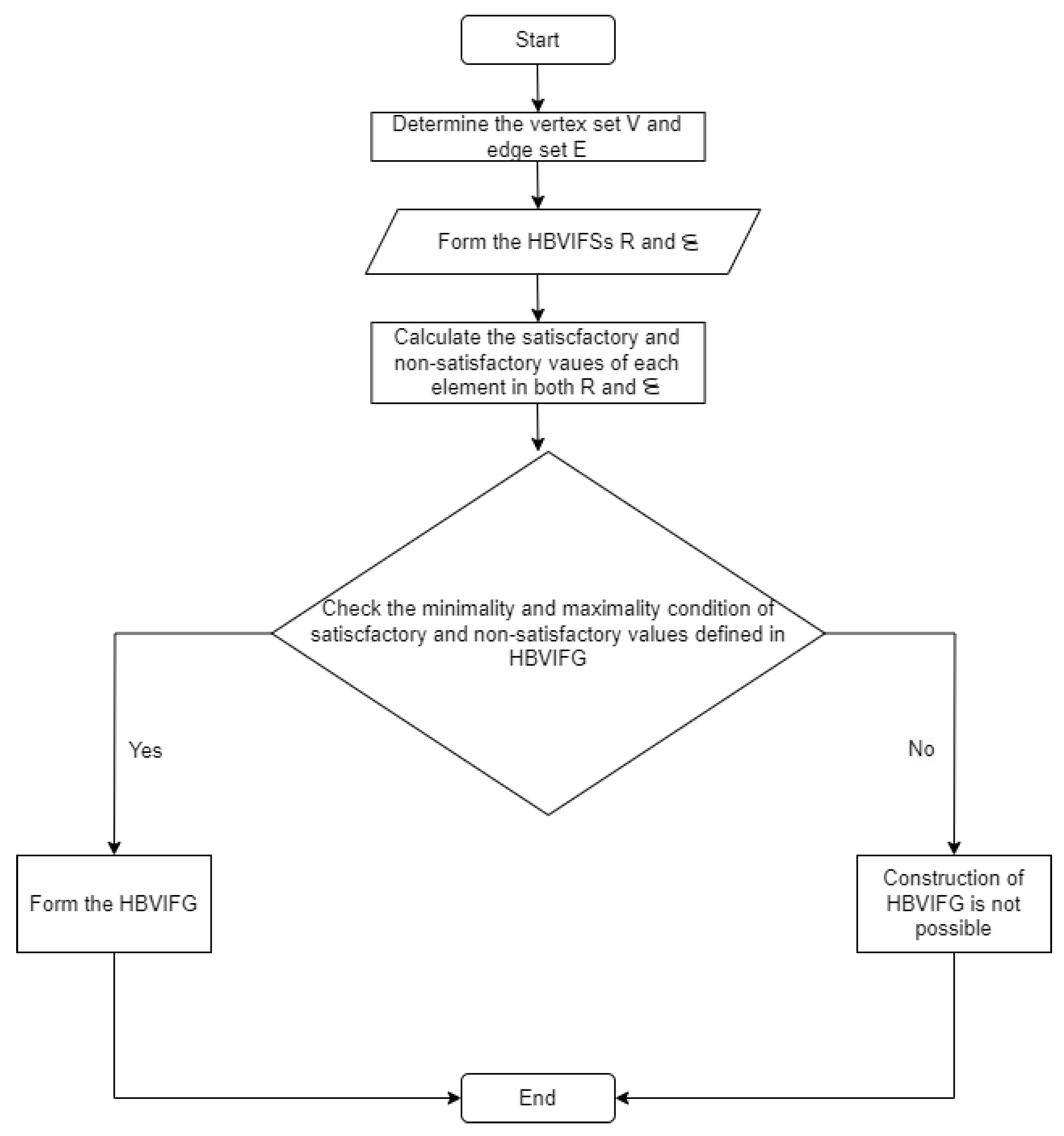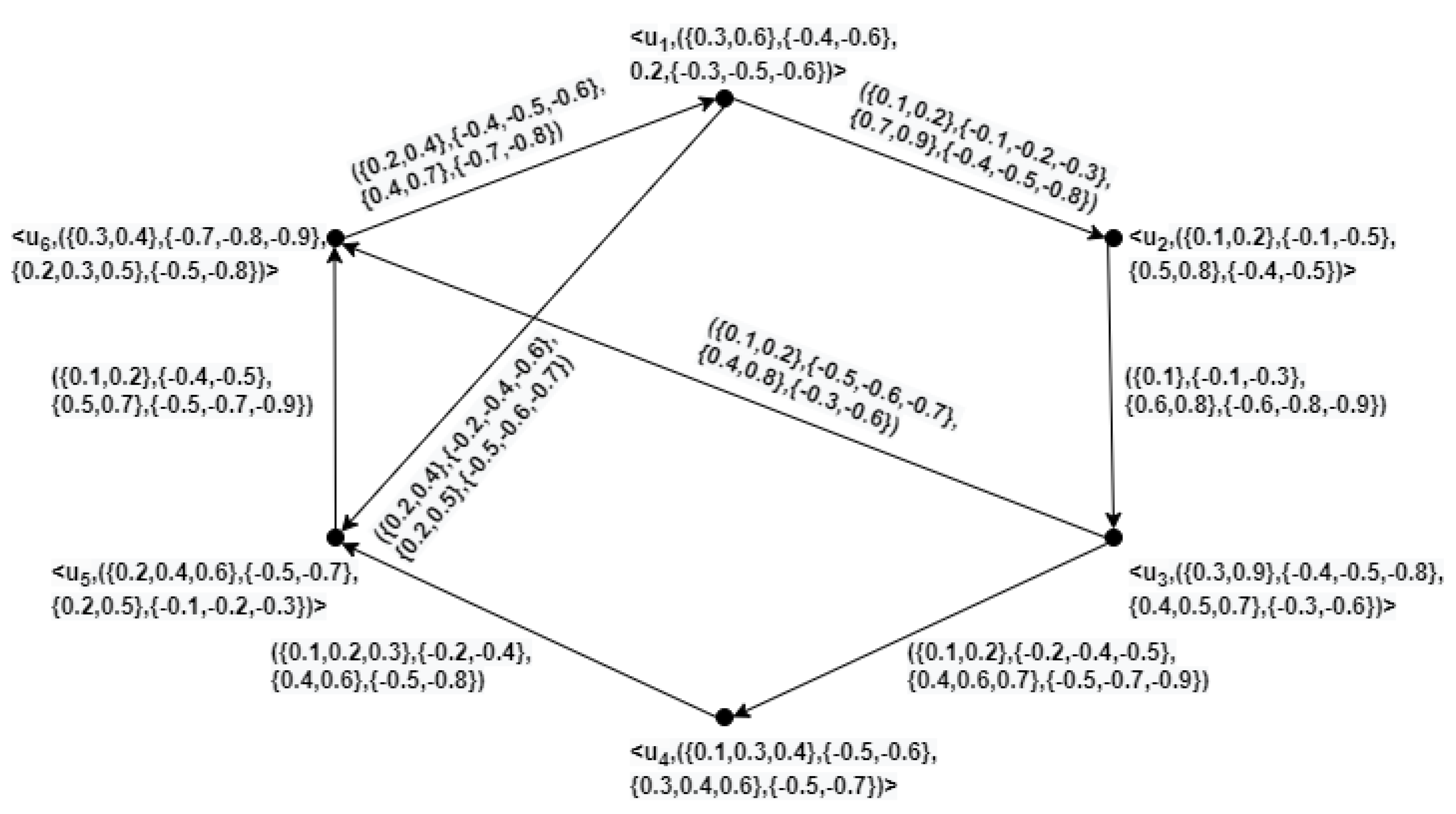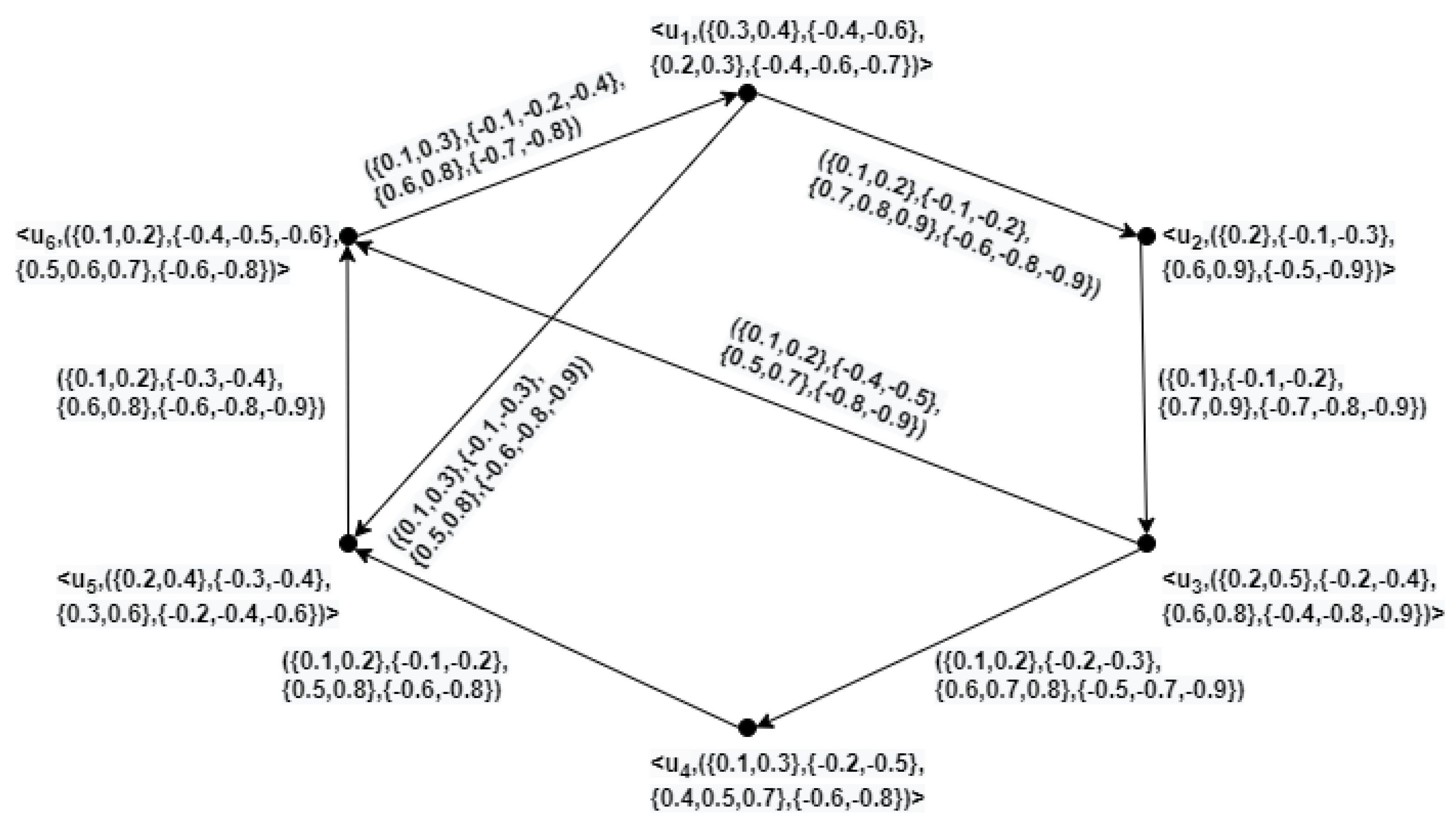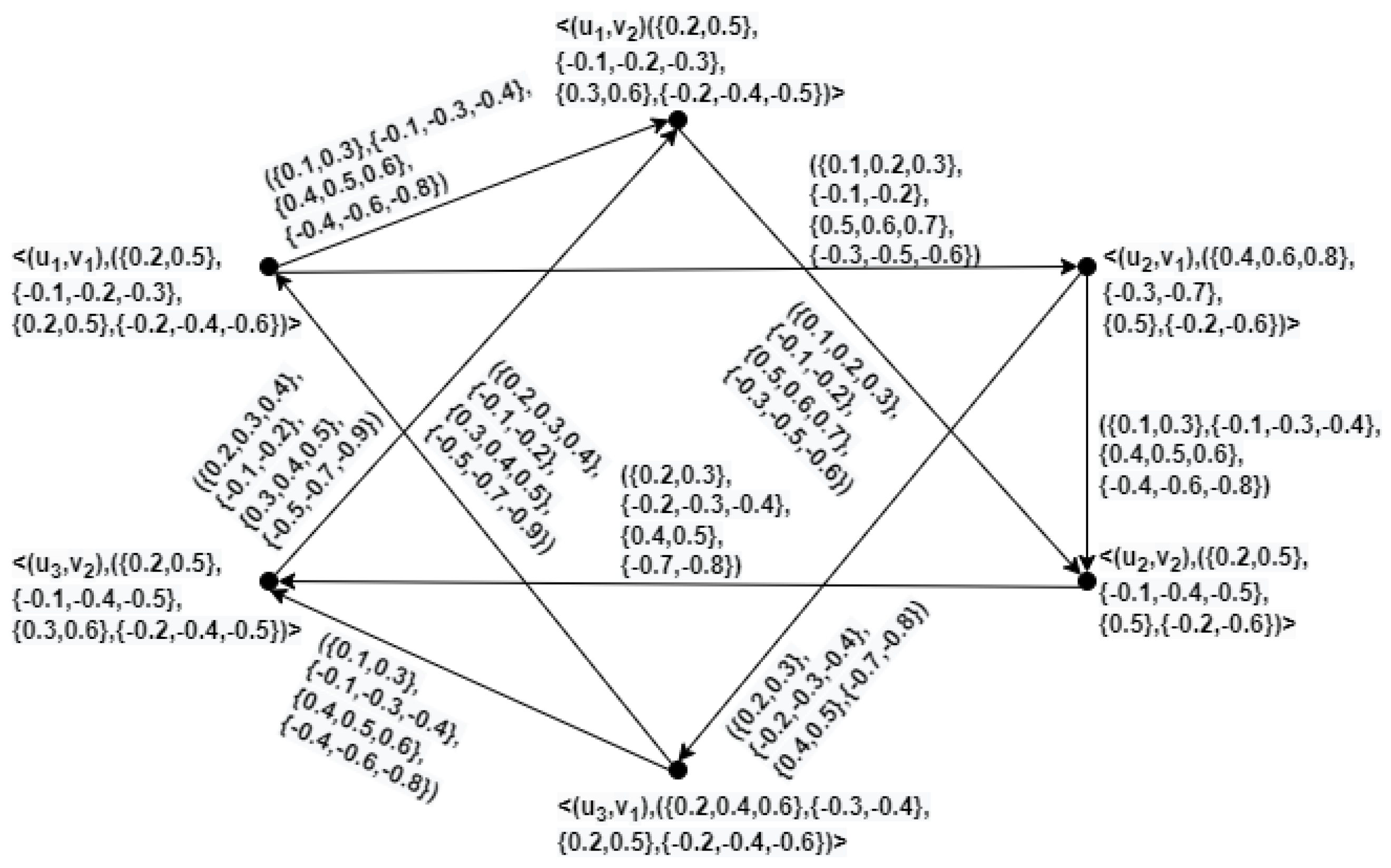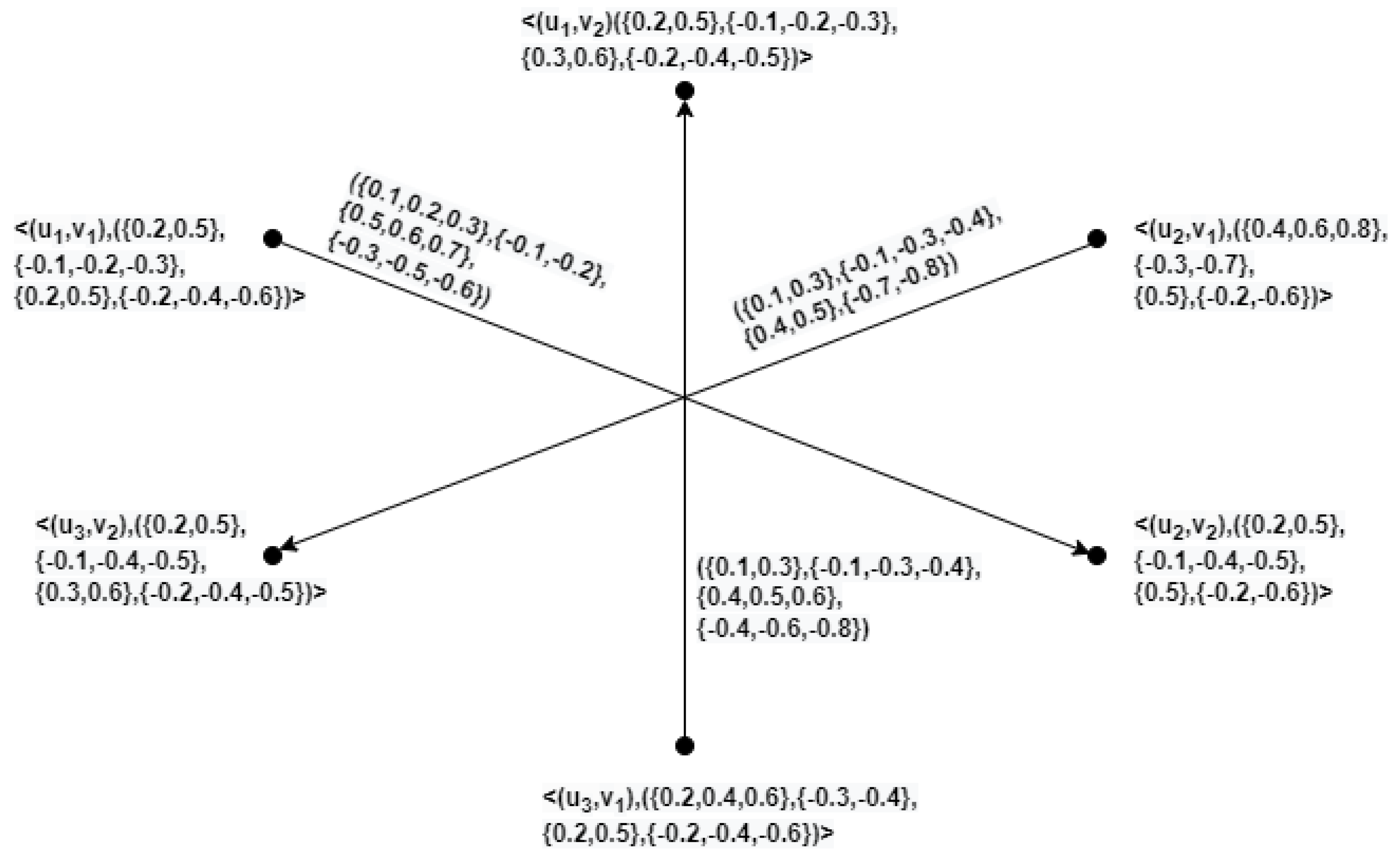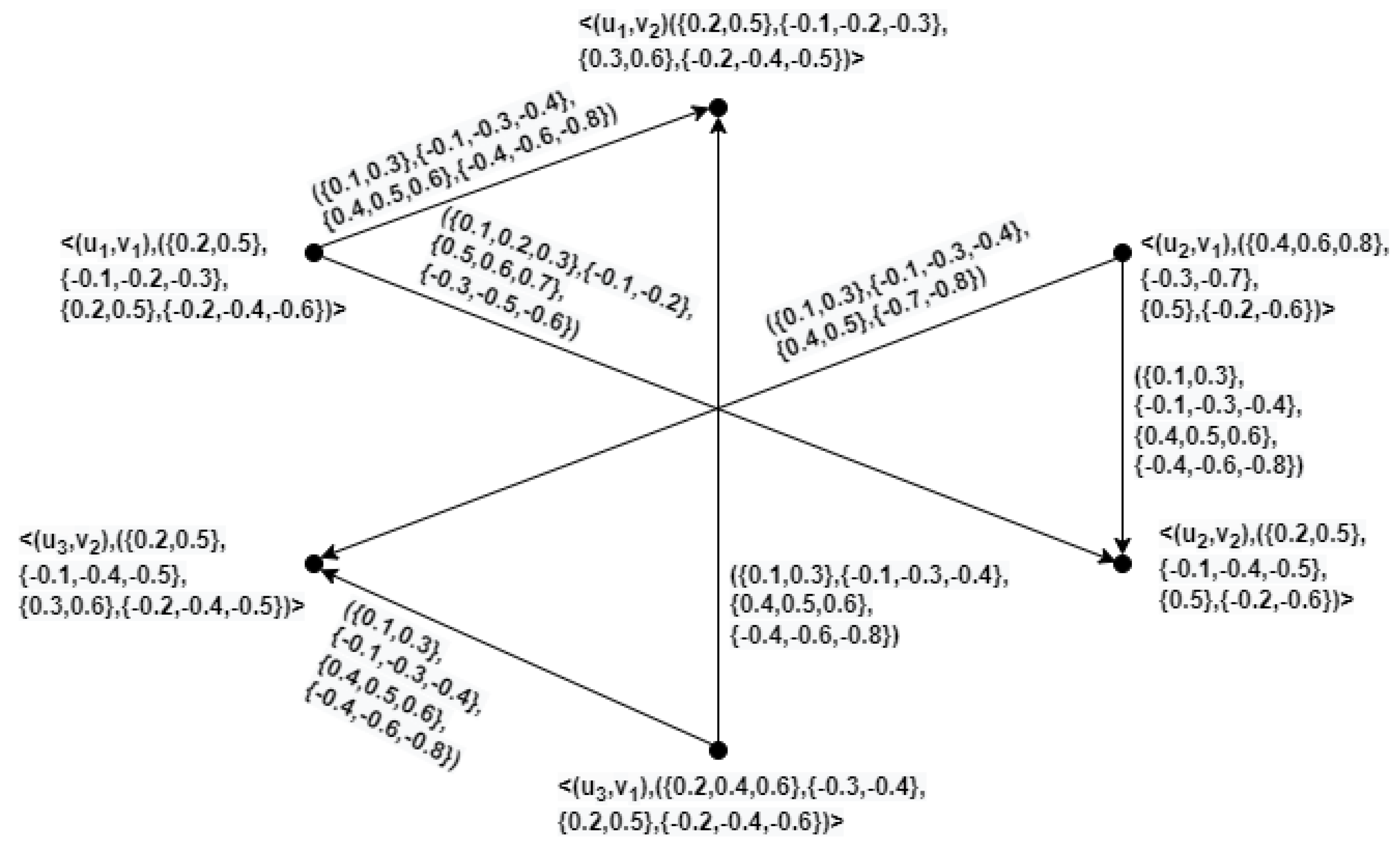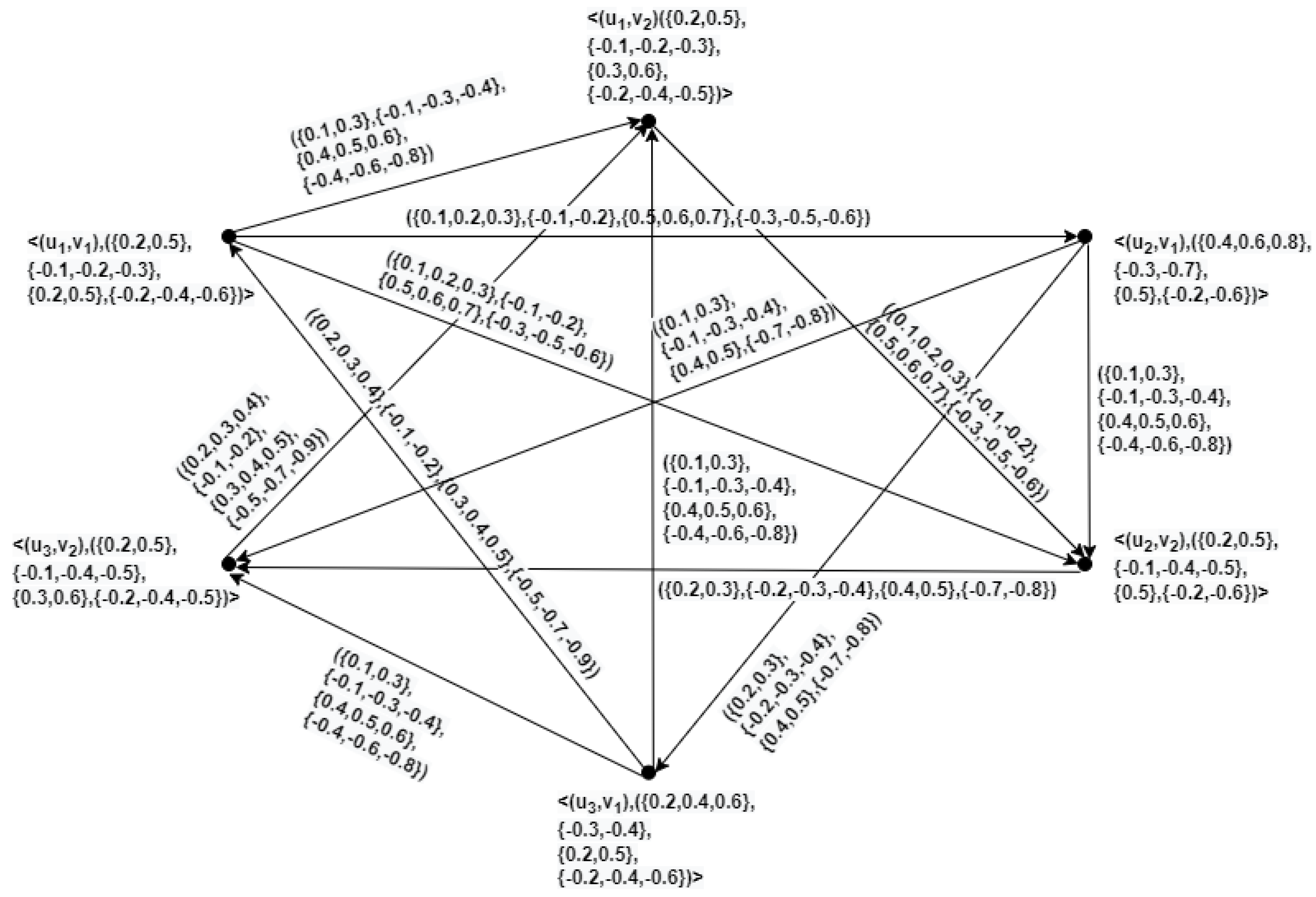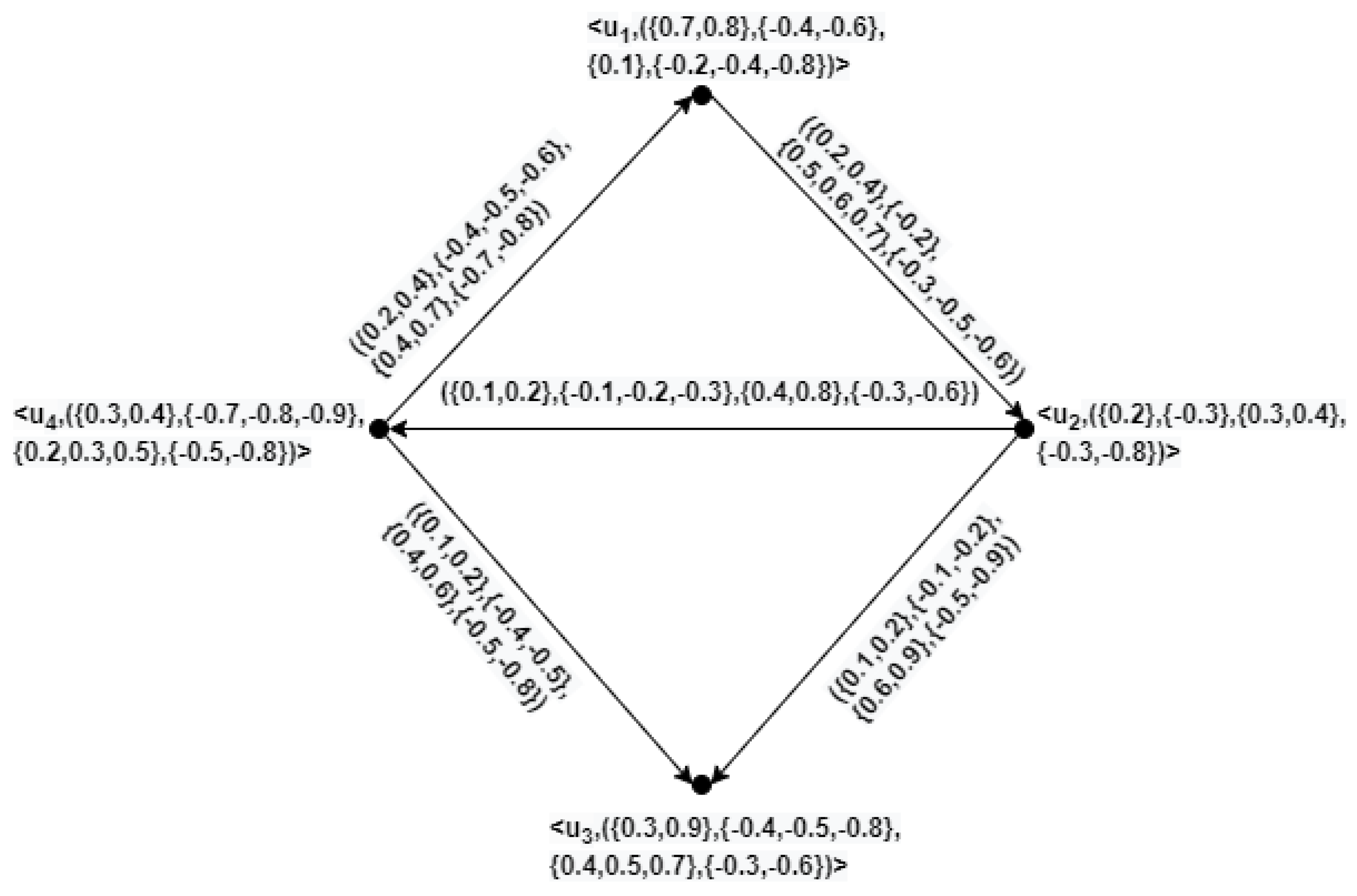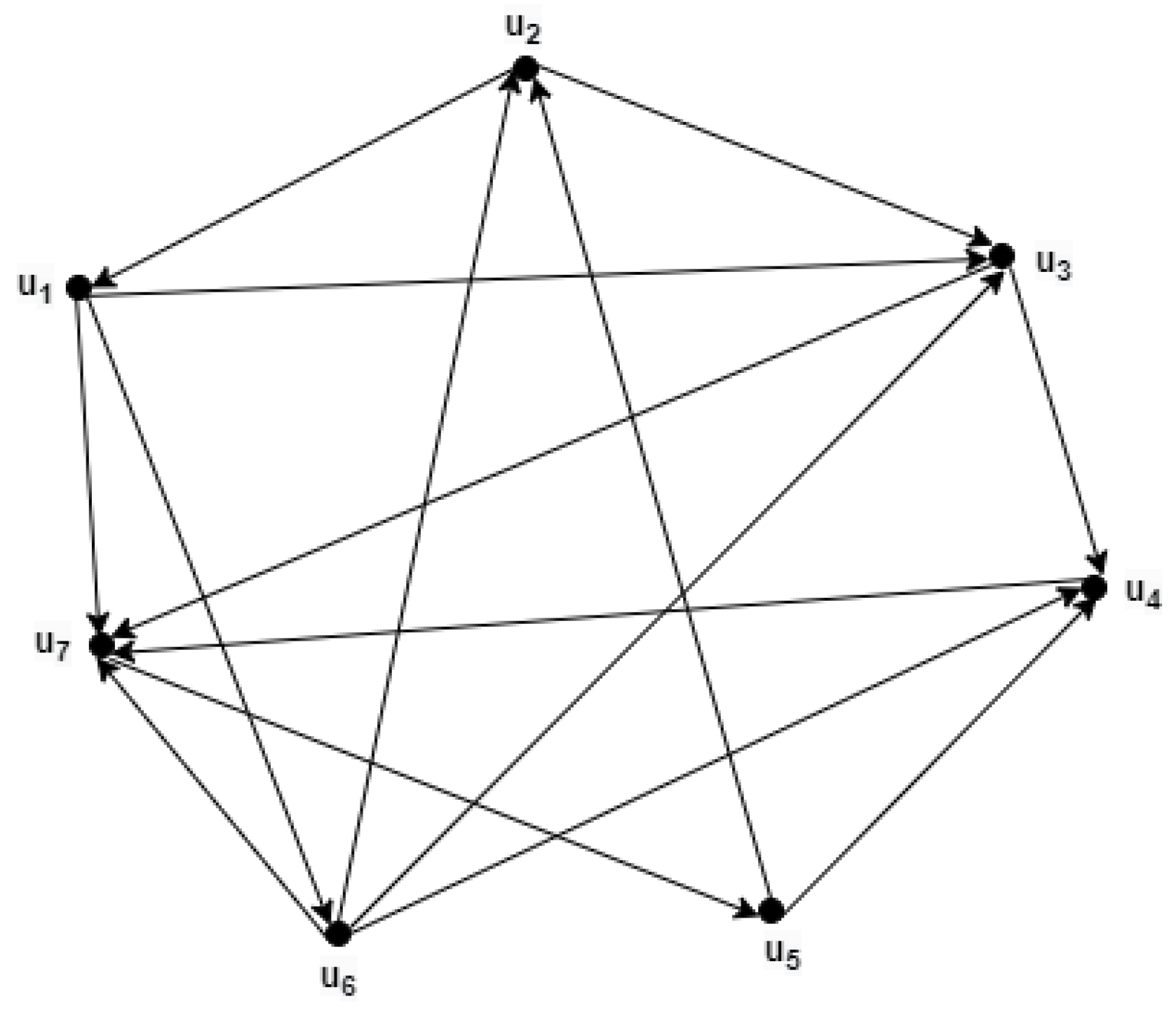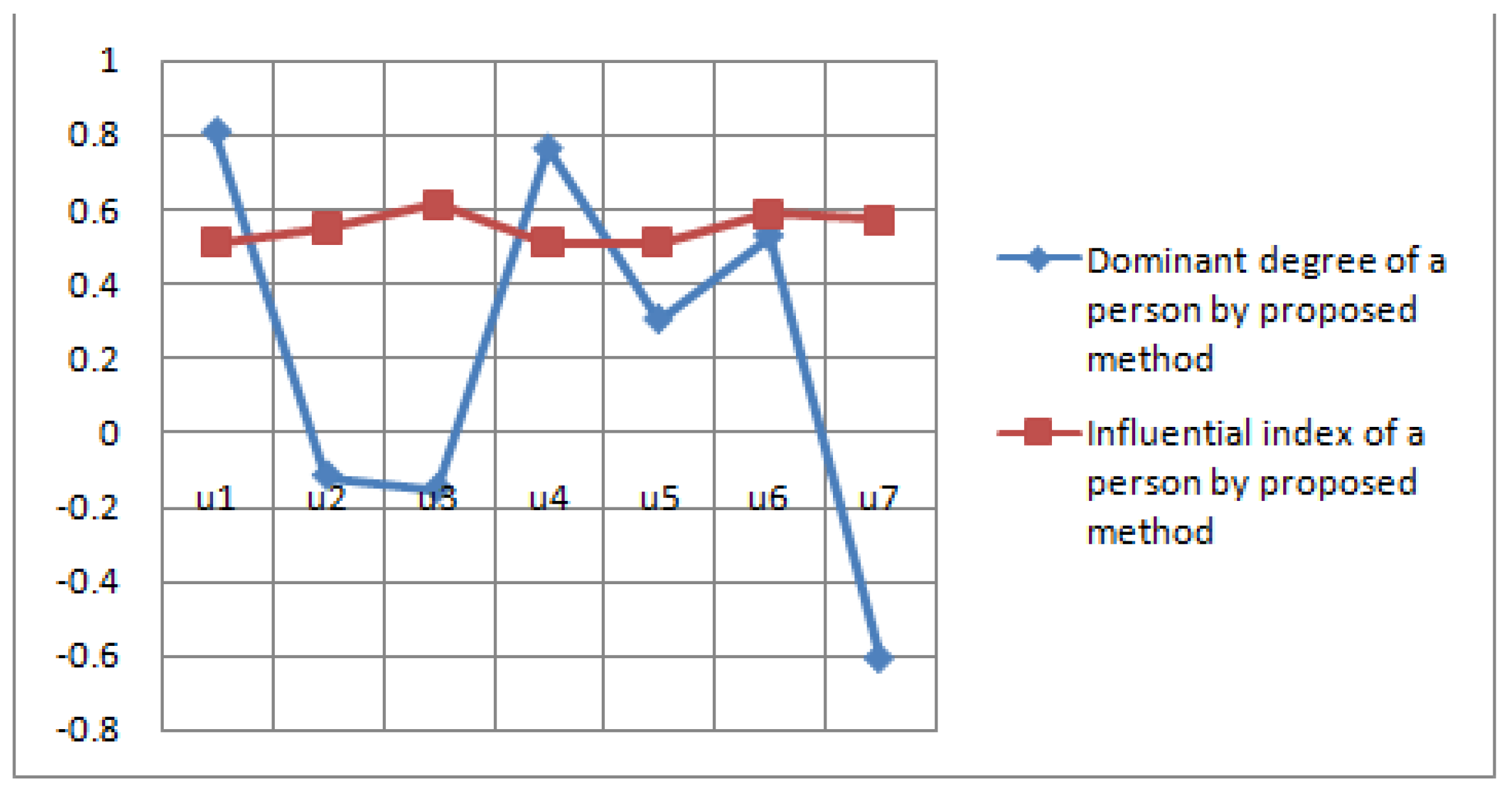2. Preliminaries
This section covers the major implications of hesitant bipolar valued fuzzy set along with its suitable instances.
Definition 1. Let be a reference set. A bipolar-valued hesitant fuzzy set (BVHFS) on is defined as . Here, contains the values in and represents the bipolar-valued membership degrees of to where such that and . The element is the BVHF element (BVHFE) of .
Definition 2. Let be BVHFE. The score function is defined aswhere l is the number of bipolar values in and is an element of . Example 1. Let be a reference set where , and . denotes the BVHF membership values of to the set . Then, is defined as is the BVHFS on .
Definition 3. Let and be the two BVHFEs of . Then, their score-based intersection is defined as Definition 4. Let be a graph. A BVHF graph (BVHFG) with V as a reference set where and are BVHFSs in V and , respectively, which is characterized by membership function and with the condition , , and , .
Example 2. Let and . The BVHFSs is defined as , and . Here, , , , , , and .
From the above calculations, it is observed that is a BVHFG of and it is represented in Figure 1. To identify the dominant and self-persistent person in a WhatsApp network, the values related to membership values (positive/negative) and non-membership values (positive/negative) have to be considered. With this observation, we developed a WhatsApp network as an HBVIFG model. The fundamental ideas of HBVFS, HBVFG, and their related concepts are presented here. These concepts are shifted to HBVIFS, HBVIFG, and their related extensions.
Definition 5. Let be a reference set. A hesitant bipolar valued fuzzy set (HBVFS) on is defined as where and are called hesitant fuzzy positive and negative elements to the set . is called the hesitant bipolar-valued fuzzy element (HBVFE) to the set . The set of all HBVFSs on is denoted by . The algebraic sum between two HBVFEs and of is defined as follows: Definition 6. Let be HBVFE of . Then,is called the score function of , where and are the numbers of the elements in and accordingly. Definition 7. Let and be the respective HBVFEs of . If , then HBVFS is a subset of HBVFS . It is denoted by .
Example 3. Let and where . .
Here, , , , , , . From Definition 7, we have, , where . Thus, .
Definition 8. Let and be two HBVFEs of . Then, their score-based intersection is defined as Definition 9. Let and be the respective HBVFEs of and . Then, the Cartesian product of is defined as Example 4. Let and . Let and where . . Here, , , , , .
Then, .
The HBVFR can be written as .
All elements in satisfy where and . For instance, take , then, = 0.4917.
Definition 10. A directed HBVF graph of is a pair Ǧ where R is an HBVIFS in whose corresponding HBVFE is and is an HBVFS in whose corresponding HBVFE is such that . .
3. Hesitant Bipolar Valued Intuitionistic Fuzzy Graph
In this section, we introduce the basic definitions including hesitant bipolar-valued intuitionistic fuzzy set (HBVIFS), its satisfactory and non-satisfactory value, score-based intersection and relation of HBVIF elements, and directed HBVIF graph along with several appropriate examples.
Definition 11. Let U be a reference set. A hesitant bipolar-valued intuitionistic fuzzy set (HBVIFS) R on U is defined as where and . The functions denote the possible satisfactory (membership) and non-satisfactory (non-membership) degree of an element whereas denote the the possible satisfactory and non-satisfactory degree of to the implicit counter property to the set U, respectively. For the sake of simplicity, we use where and for the hesitant bipolar-valued intuitionistic fuzzy element (HBVIFE). The set of all HBVIFS is denoted by .
Definition 12. Let be HBVIFE of . The hesitant bipolar-valued intuitionistic fuzzy satisfactory value (HBVIFSV) is defined as The hesitant bipolar-valued intuitionistic fuzzy non-satisfactory value (HBVIFNSV) is defined as Definition 13. Let and be two HBVIFEs of . If and , then HBVIFS R is a subset of HBVIFS S. It is denoted by .
Example 5. Let and where . .
Here, , , , , , , , , , , , . From Definition 13, we have, and where . Thus, .
Definition 14. Let and be two HBVIFEs of . Then, their score-based intersection is defined as Proposition 1. Let and be two HBVIFEs of . If , then and .
Proposition 2. Let and be the corresponding HBVIFEs of , respectively, then
,
.
Definition 15. Let and be two HBVIFEs of and , respectively. Then, the Cartesian product of is defined as Definition 16. Let and be two HBVIFEs of and , respectively. Then, the hesitant bipolar-valued intuitionistic fuzzy relation (HBVIFR) Q from HBVIFS R into HBVIFS S is an HBVIFS on such that
,
.
and is the corresponding HBVIFE of Q. If , then Q is called HBVIFR on U, respectively.
Example 6. Let and . Let and where . .
Here, , , , , , , , , , .
Then, .
The HBVIFR Q can be written as .
All elements in Q satisfy and where and . For instance, take , then, and .
Definition 17. A directed HBVIFG of is a pair Ǧ where R is an HBVIFS in V whose corresponding HBVIFE is and is an HBVIFS in whose corresponding HBVIFE is such that
,
.
. Here, R is the hesitant bipolar-valued intuitionistic fuzzy node set (HBVIFNS) of Ǧ and is the hesitant bipolar-valued intuitionistic fuzzy edge set (HBVIFES) of Ǧ, respectively. Furthermore, is symmetric HBVIFR on R. The elements and are omitted. Figure 2 shows the flowchart representation of constructing HBVIFG. Example 7. Let and . The HBVIFSs are defined as .
Here, , , , , , , , , , , , . .
Here, , , , , , , , , , , , , , , , . From the above calculations, it is observed that Ǧ is a directed HBVIFG of and it is represented in Figure 3. Remark 1. HBVIFG is the generalization of both HBVFG and BVHFG as it can handle the uncertain information possessing membership and non-membership values along with their positive and negative aspects simultaneously.
Furthermore, it is possible to include multiple attribute values with respect to both positive and negative sides in each of its membership and non-membership grades and thus facilitate a better understanding of uncertain/imprecise information.
Definition 18. Let Ǧ and Ȟ be a directed HBVIFG of . Then, Ȟ is called a partial directed HBVIFSG of Ǧ if , , and , .
Example 8. Let Ȟ be a directed HBVIFG of where .
Here, , , , , , , , , , , , . .
Here, , , , , , , , , , , , , , , , .
From the above calculations, it is observed that Ȟ is a partial directed HBVIFG of Ǧ and is given in Figure 4. Definition 19. Let Ǧ and Ȟ be a directed HBVIFG of and . Then, Ȟ is called a directed HBVIFSG of Ǧ induced by if , , , and , .
Example 9. Let Ǐ be a directed HBVIFG of where and .
The HBVIFSs are defined as .
Here, , , , , , , , . .
Here, , , , , , , , . From the above calculations, it is observed that Ǐ is a directed HBVIFSG of Ǧ .
Definition 20. Let Ǧ and Ȟ be a directed HBVIFG of . The span of Ǧ is a partial directed HBVIFSG Ȟ if , , . Furthermore, Ȟ is called a spanning directed HBVIFSG of Ǧ .
Definition 21. A directed Ǧ of is called a strong directed HBVIFG if , , .
Definition 22. A directed Ǧ of is called a complete directed HBVIFG if , , .
4. Product of HBVIFG
This section discusses the operations of HBVIFGs. Various operations including Cartesian product, direct product, lexicographic product, and strong product are introduced. Further, it is verified that the directed HBVIFG is obtained after all these operations. In addition, the homomorphic and isomorphic mapping relations are discussed.
Definition 23. Let and be directed HBVIFGs of and , respectively. Then, we have:
The Cartesian product of and is defined as follows:
- (a)
,
,
- (b)
,
,
- (c)
,
,
The direct product of and is defined as follows:
- (a)
,
,
- (b)
,
,
The lexicographic product of and is defined as follows:
- (a)
,
,
- (b)
,
,
- (c)
,
,
The strong product of and is defined as follows:
- (a)
,
,
- (b)
,
,
- (c)
,
,
- (d)
,
,
Example 10. Let and be two directed HBVIFGs as given in Figure 5. Then, , , , and of and are represented in Figure 6, Figure 7, Figure 8, and Figure 9, respectively. Theorem 1. Let and be directed HBVIFGs of and , respectively. Then,
is a directed HBVIFG of .
is a directed HBVIFG of .
is a directed HBVIFG of .
is a directed HBVIFG of .
Proof. (1)
Case 1 For all
, we have
Case 2 Let
, then,
Case 3 Let
From Case 1, 2, and 3, is a directed HBVIFG of . The remaining operations can be proved in a similar way. □
Note The working procedure of Theorem 1 is given here. For instance, from
Figure 5 and
Figure 6, consider,
,
,
and
,
and
. Their HBVIFSVs and HBVIFNSVs are
,
,
,
,
,
,
,
,
,
,
and
. To check whether these HBVIFEs satisfy the minimality and maximality conditions provided in Definition 17, we employ Theorem 1. We have
. From Theorem 1, Case 2, we have
Thus, the minimality and maximality conditions provided in Definition 17 is satisfied using Theorem 1. The other minimality and maximality conditions can be obtained in the same manner. Thus, is the resulting directed HBVIFG obtained using Theorem 1.
Definition 24. Let and be directed HBVIFGs of and , respectively. Then, the mapping relationships of directed HBVIFGs are defined as follows:
The homomorphism between and is a bijective mapping which satisfies
- (a)
, .
- (b)
, .
The isomorphism between and is a bijective mapping which satisfies
- (a)
, .
- (b)
, .
The weak isomorphism between and is a bijective mapping which satisfies
- (a)
g is a homomorphism.
- (b)
, .
The co-weak isomorphism between and is a bijective mapping which satisfies
- (a)
g is a homomorphism
- (b)
, .
Example 11. Let , and is defined as , and . Let and be a directed HBVIFGs of and , respectively, where . . and .
Here, ,, , , ,, , , and . Therefore, g is a isomorphism between and .
Definition 25. Let Ǧ be a directed HBVIFG of , respectively. Then, a sequence of some distinct nodes , is called a directed path of Ǧ if and for some .
Definition 26. Let be a directed path of length n in a directed HBVIFG Ǧ. This path is called a cycle, if for . Further, the degree of the directed path from c to d is defined as: Example 12. Let and , and the corresponding HBVIFG is given in Figure 10. Here, forms a directed path of length 2. Furthermore, forms a directed cycle. The degree of directed path from c to d is and d is . 
